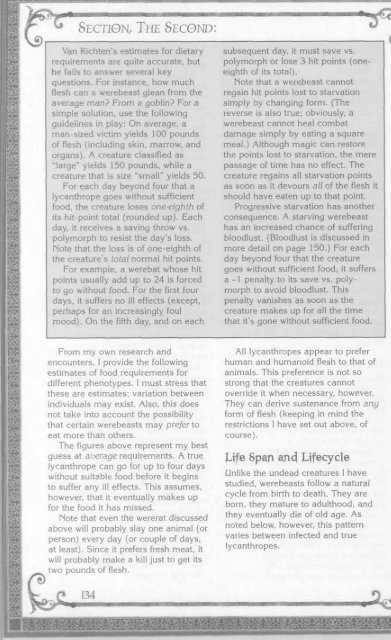Van Richten's Monster Hunter's.pdf - Askadesign.com
Van Richten's Monster Hunter's.pdf - Askadesign.com
Van Richten's Monster Hunter's.pdf - Askadesign.com
Create successful ePaper yourself
Turn your PDF publications into a flip-book with our unique Google optimized e-Paper software.
<strong>Van</strong> <strong>Richten's</strong> estimates for dietary<br />
requirements are quite accurate, but<br />
he fails to answer several key<br />
questions. For instance, how much<br />
flesh can a werebeast glean from the<br />
average ran? From a goblin? For a<br />
simple solution, use the following<br />
guidelines in play: On average, a<br />
man-sized victim yields 100 pounds<br />
of flesh (including skin, marrow, and<br />
organs). A creature classified as<br />
"large" yields 150 pounds, while a<br />
creature that is size "small" yields 50.<br />
For each day beyond four that a<br />
lycanthrope goes without sufficient<br />
food, the creature loses one-eighth of<br />
its hit-point total (rounded up). Each<br />
day, it receives a saving throw vs.<br />
polymorph to resist the day's loss.<br />
Note that the loss is of one-eighth of<br />
the creature's total normal hit points.<br />
For example, a werebat whose hit<br />
points usually add up to 24 is forced<br />
to go without food. For the first four<br />
days, it suffers no ill effects (except,<br />
perhaps for an increasingly foul<br />
mood). On the fifth day, and on each<br />
From my own research and<br />
encounters, I provide the following<br />
estimates of food requirements for<br />
different phenotypes. I must stress that<br />
these are estimates: variation between<br />
individuals may exist. Also, this does<br />
not take into account the possibility<br />
that certain werebeasts may prefer to<br />
eat more than others.<br />
The figures above represent my best<br />
guess at average requirements. A true<br />
lycanthrope can go for up to four days<br />
without suitable food before it begins<br />
to suffer any ill effects. This assumes,<br />
however, that it eventually makes up<br />
for the food it has missed.<br />
Note that even the wererat discussed<br />
above will probably slay one animal (or<br />
person) every day (or couple of days,<br />
at least). Since it prefers fresh meat, it<br />
will orobablv make a kill iust to aet - its<br />
two pounds'of flesh.<br />
subsequent day, it mus t save vs.<br />
polymorph or lose 3 hit points (oneeighth<br />
of its total).<br />
Note that a werebea: jt cannot<br />
regain hit points lost to starvation<br />
simply iy changing for m. (The<br />
reverse is also true; obi Jiously, a<br />
werebeast cannot heal <strong>com</strong>bat<br />
damage simply by eatii Tg a square<br />
meal.) Although magic can restore<br />
the points lost to starvz ition, the mere<br />
passage of time has no effect. The<br />
creature regains all stai (vation points<br />
as soon as it devours a ll of the flesh it<br />
should have eaten up t' 3 that point.<br />
Progressive starvatic ,n has another<br />
consequence. A starvir rg werebeast<br />
has an increased cham :e of suffering<br />
bloodlust. (Bloodlust is discussed in<br />
more detail on page 1E io.) For each<br />
day beyond four that tt Le creature<br />
goes without sufficient food, it suffers<br />
a -1 penalty to its save ~ vs. polymorph<br />
to avoid bloodli 1st. This<br />
penalty vanishes as so< m as the<br />
creature makes up for all the time<br />
that it's gone without SI ufficient food.<br />
All lycanthropes apF )ear to prefer<br />
human and humanoid flesh to that of<br />
animals. This preferem :e is not so<br />
strong that the creaturc 3s cannot<br />
override it when neces: jary, however.<br />
They can derive suster lance from any<br />
form of flesh (keeping in mind the<br />
restrictions I have set c ut above, of<br />
course).<br />
Life Spm and Lift 3cycle<br />
Unlike the undead crez itures I have<br />
studied, werebeasts fol low a natural<br />
cycle from birth to dea th. They are<br />
born, they mature to at dulthood, and<br />
they eventually die of ( ,Id age. As<br />
noted below, however, this pattern<br />
varies between infectec 1 and true<br />
lycanthropes.


